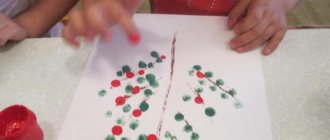Forms of organizing joint activities
| Children's activities | Forms and methods of organizing joint activities |
| Motor | 1. Outdoor game “Harvesting”. 2. Articulation gymnastics. |
| Gaming | Didactic game “Gifts from Dunno - a bag of fruits.” |
| Productive | Album design - paste pictures of fruits. |
| Cognitive and research | Solving a problem situation (how to grow a square watermelon), experience. |
| Communicative | Questions, speech situations. |
| Perception of fiction | Listening to (and guessing) poetic riddles. |
Open lesson in the middle group on the topic “Child and the world around us”
Open lesson in middle group
"The child and the world around him"
Topic : “Introduce children to the concept of “Vitamins”
Goal: to introduce children to the concept of vitamins.
Software tasks:
Introduce children to the concept of “vitamins” and vitamins A, B, C.
to form in children an idea of healthy foods that contain vitamins.
Develop olfactory and taste analyzers.
Development of fine motor skills of the hands.
Practice solving riddles.
To instill in children a sense of empathy and a desire to help.
Develop acting skills in children.
Equipment: Phil, three easels with posters depicting vitamins A, B, C;
Fruits: apple, lemon, orange, peach, apricot;
Vegetables: tomato, carrots, onions, garlic, cabbage, potatoes;
Dummy fruits and vegetables in a basket;
Plates according to the number of children;
Tape recorder, cassette with an audio recording of the song “Cheburashka”, “Classics for Kids”
Progress of the lesson
Introductory part
Educator: guys, look how many guests came to visit us. Say hello. I am very glad to see you all so beautiful and healthy today. Tell me in what mood you came to class.
(Good, cheerful, smiling, perky, kind).
Share your good mood with each other. Smile at each other.
Educator: Today we will go on a trip to an amazing country called Vitaminia.
Main part
Educator: Oh, who is that crying?
Sad Filya sits behind the house.
The children greet Filya.
Educator: Filya, why are you so sad? Let's feel sorry for him. Pet Phil, guys.
Filya: “I had a problem, I got sick. I don’t eat, I don’t feel like having fun.. Neither cake nor ice cream makes me happy. Do you guys have a cure for this disease? You see - everyone is so beautiful, healthy and pink cheeks, you probably know some secret? Share your secret with me."
Educator: “Let’s share, we were just about to go on a trip to the country of Vitaminia, will you fly with us? Guys, make yourself comfortable and get ready to fly. Relax, close your eyes. We're flying high. The sun is pleasantly warming, the wind blows on our faces. We are flying. Now open your eyes.
(they are met by a doctor in a white coat)
Doctor: Hello guys! ...do you know what the word “hello” means?
Children: Yes. We greet the person and wish him health.
Educator: Doctor, our Karim and Salim know sayings about health.
“Eat garlic and onions, you won’t get sick.” “An apple a day gets doctors out the door.”
Doctor: You have entered the country of Vitaminia. Listen carefully to our secrets. Vitamins are substances that help children grow strong and healthy. Both plants and animals can produce vitamins themselves, but humans cannot do so. Therefore, a person must receive vitamins from food. A lot of vitamins are found in fruits and vegetables, as well as in other foods that people eat. And if a child receives few of these vitamins, then he begins to get sick often, loses his appetite and grows poorly.”
Summary of direct educational activities in the middle group of kindergarten.
Summary of direct educational activities in the middle group of kindergarten.
Indoor plants in a kindergarten are not only a piece of furniture, but also a means of air purification, a means of “acquaintance” and communication between children and nature. we are so accustomed to flowers on the windowsill that they have become part of our life, a life that is bright, green, fluffy and glossy, but always bringing joy. Target
: Remember the names of indoor plants, their parts and actions for caring for plants (watering, loosening the soil, wiping or spraying leaves).
Objectives:
Educational.
Instill an interest in indoor plants and a desire to care for them. Cultivate a positive attitude towards nature, a love of work, in order to enjoy work. Educational. Exercise children to speak in complete sentences, coordinating adjectives with nouns. Developmental. Develop aesthetic taste, the ability to receive positive emotions from the sight and contact with indoor plants. Develop the ability to describe an object, highlighting its parts and characteristic features. Materials Indoor flowers in pots, pictures of indoor plants, a cube with indoor plants depicted on its sides. Preliminary work. Daily care for indoor plants, observing them. Introducing indoor plants in previous sessions on the topic “Getting to know indoor plants.” Children become familiar with the names of plants, their parts, and techniques for caring for indoor plants. The course of the educational activity itself:
(Children sit at the tables in their places).
- Guys, would you like to go on a trip? (Children's answers) - Great, I also want to travel. We just need to think about where we should go? Tell me, where would you like to go on a trip and why? (Children's answers). -Wonderful, any trip is fraught with a lot of new and interesting things. When a person goes on a trip, he thinks, what interesting and memorable things will I see? Many of you have traveled: flown to different countries, traveled to big and small cities. Today, I I suggest you take a trip to the “City of Flowers”. Let's go? (Children line up in a circle). -Now, guys, close your eyes, and I will cast a magic spell that will help us find ourselves in the magical “City of Flowers.” (I read the spell, and at this time I put pots with indoor plants and pictures of indoor plants on the table. (You can turn on an audio recording of nature, birdsong). Spell.
In our group, on the window, on the green side, in painted pots, flowers have grown. Open your eyes and see a fairy tale. -Guys, open your eyes. Look how beautiful it is around. Tell me, what changes did you see? (Children's answers). - Absolutely right, we ended up in the magical “City of Flowers”, that’s why we have so many of them .Tell me, what names of indoor plants do you know? (Children's answers). -Well done, guys, you know a lot of names. Let's play with you.
Game with a cube:
Children stand in a circle. In turn, each child throws a cube and talks about that home the plant that falls out on the top edge of the cube. The teacher starts first and the children continue following his example. The name of the plant is said, what parts of the plant are, what is the height of the stem, what is the shape of the leaves, does it bloom, how to care for the plants and what benefits they bring to people. If a child finds it difficult to answer, we help him with leading questions. If the plant is flowering, the game develops in the other direction: for example, the violet has pink flowers. The teacher invites the children to look at the other children and say who has pink on their clothes. -Well done, guys, let's speak in complete sentences. Listen to me tell the story, and then you will tell it. I describe the clothes of a child who has pink on his clothes, then I invite several children to describe the clothes of other children. -Guys, we had fun playing, listened to stories about many indoor plants, but didn’t talk about how to care for them. Who can tell us about caring for indoor plants? Who has indoor plants at home and who cares for them? (Children's answers). - Well done, guys, they said everything correctly, that the flowers need to be watered, the soil needs to be loosened so that the roots can breathe, the leaves of some plants can be wiped or sprinkled. With our work we extend the life of the plants, they will grow for a long time and bloom beautifully, delighting us and our friends with his appearance. guys, tell me, when you look at indoor plants, does your mood lift, do you feel happy or sad? (Children's answers). - Of course, the sight of indoor plants lifts our spirits, and plants also bring benefits to people: for example, aloe juice can treat wounds and burns, and the juice can be dropped into the nose and there will be no runny nose. But children cannot treat themselves, this is a must Only parents do it, the plant allows treatment only to an adult. You don’t know how yet and can damage the plant, causing it to dry out. Therefore, just tell your parents about the beneficial properties of aloe so that they also know. Well done today, the trip was a success, but you and I need to return to the group. (Children line up in a circle, close their eyes, read a spell, open our eyes and children sit down). - Well, guys, we have returned from a trip, and so that we have a memory of it, I suggest that in your free time you draw the indoor plants that you liked the most.
(To the music, children draw indoor plants. When finished, we look at the drawings and guess whose drawing it is and what plant is depicted on it).
Middle group. Junior preschool age. Children 4 - 5 years old
Notes on modeling "My funny ringing ball" for children of the middle group
Greetings to all. Dear readers, I bring to your attention a summary of direct educational activities for preschool children (4-5 years old)
"My funny ringing ball." Goal: to teach children to sculpt round objects from plasticine using circular movements of their palms...
Notes on non-traditional drawing in a combined technique “Snowman” in the middle group Valentina Shabanova Goal. Practice combining two different techniques to create a semi-volume image of snowmen. Tasks. Expand children's understanding of the winter season. Encourage children to name the main signs of winter. Continue to introduce children to winter...





